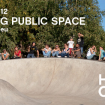About
Network 2010-2012
Human Cities acts as a European Network, opening the door to extensive collaborations between Brussels, St. Etienne, Milan and Ljubljana, where partners develop specific themes around sustainable urban design.
Human Cities main partners
Pro Materia, Brussels, BE
Faculté d’Architecture La Cambre Horta, Brussels, BE
Politecnico di Milano, Milan, IT
Urban Planning Institute of the Republic of Slovenia * UIRS, Ljubljana, SLO
La Cité du design, St Etienne, FR
Associated partners are:
Esterni, Milan, IT
ProstoRoz, SLO
Research topics
Public Design
The Brussels team will focus its researches and contributions on qualitative studies based on the perception and the behaviours of people in urban public places. We propose to analyse the appropriation, the uses or the misuses of urban objects and forms by the people. We will also analyse how people divert or misuse some of these urban objects or spaces in order to find a solution to a problem they could not solve properly (ex: homeless people using public benches to sleep. Teenagers who gather in public places and around some public objects (benches,…) because they do not have a particular place to express themselves).
Sustainable Communities
The Politecnico will focus on “Social innovation and public spaces”. It starting point is how social innovation (and in particular the creative communities) may generate new and more sustainable ways of living in the city (and especially how the solutions they generates may inspire new collaborative services). From this micro scale level we now consider how these many social initiatives may scale-up and reticulate at a territory level to generate new and more sustainable cities (or Human Cities…)
Pedagogy
The Cité du design, Saint-Etienne, France , involved in Human Cities 2 will organize a workshop on the topic : “The youth and its practices in the public space” on 30th June and 1st July 2011 in the new creative area of the Manufacture Plaine Achille . It’s an opportunity to work on an urban regeneration area with the Human Cities 2 partners and various local partners : Saint-Etienne School of Art and Design, urban planning institutions, cultural, sports, and youth associations sharing different uses of the public spaces and experiences already engaged by different youth populations on this area. It will contribute to the urban development program policy . Together with the Politecnico di Milano, Strategic Design Scenario and associated partners, the Cité du design will realize a toolkit addressed to European local governments, citizens and associations. Based on case studies, it will present a set of tools to enable citizens to re-invest, re-appropriate, re-use public spaces as an open, rich and inviting common goods.
Mapping
The Slovenian team will focus on GIS mapping methods. These methods for public space evaluation are based on the exploration of people’s engagement with public spaces. The first, “Observation & behavioural mapping”, explores physical form and dynamic patterns of spatial occupancy in parks and squares, the second, “Interviews & cognitive mapping”, examines connectedness and extension of neighbouring places in a common mental image. Thus, quality of places is addressed with the approaches which gather information and offer insights about places through the “people” component. At the same time it is of key importance that such qualities are presented in the medium designers are familiar with. Visual communication is a key communication tool in urban design profession, therefore maps and map-making are crucial components in selection of methods and techniques relevant to research in urban design and related disciplines. This is especially prominent when communicating qualitative characteristics of places which primarily concern non-spatial attributes of places such as activities people are involved with in places or conceptions of places.
Festivals
15 – 31 March 2012
Human Cities Festival 2012: Reclaiming Public Space
29 September – 03 October 2010
Brussels Istanbul: Designing public space
06 – 16 May 2010




